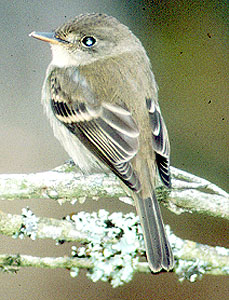
Don DesJardin photographed this curlew at Goleta Beach, California, 9 June 1998.
Peter LaTourrette photographed this interesting Empidonax at the Point Reyes "Fish Docks" 12
September 1988.
The flycatcher was very puzzling to me. It is part of a series of photographs by Pete LaTourrette and generously donated to my teaching collection. I recently covered Empidonax flycatchers in my class and was puzzled by the appearance of this bird. My initial reaction was that it was a Willow because of the overall brownish coloration, faint eye-ring and large looking bill. But the shape seemed wrong. It looks big-headed and short-tailed, more like a Least Flycatcher. The odd thing to me is that normally, Willow and Least don't look anything alike. There are hardly two more dissimilar Empidonax flycatchers in North America. How is it that I couldn't decide between these two very different birds?
I was gratified to see that many of the contributors to our public comments page had exactly the same reaction as I did, and were just as puzzled. The consensus, and I agree, is that this bird is a Trail's Flycatcher in the broad sense; a Willow/Alder flycatcher if you will. I'm still hesitant to join the fray in trying to get this bird to subspecies. Heck, if I couldn't tell whether it was a Least or a Trail's, I don't have much confidence in my ability to distinguish subspecies of Willow Flycatcher in the field, and especially not in a single photo.
The color may be a bit off on the web image, so that makes it even more treacherous. Pete LaTourrette wrote:
I checked my remaining slides and found some of Empid(s) I called Willow at the Lighthouse that same date. I no longer have any of the bird at the Fish Docks that day, but I suspect that I called it a Willow also. I seem to remember several similar Empids on the outer point that day. The shots I have show more chestnut color to the wing bars than your scan does.
Phil Unitt is an authority on this complex. I solicited his opinion and he wrote:
I can view your flycatcher picture only at home, not at the museum, where I might be able to compare it with specimens..... The wingbars are clearly juvenile but look too pale (yellow-buff, not ochre) for the subspecies of the Willow Flycatcher expected along the coast of northern California, brewsteri. The upperparts look too pale for an Alder Flycatcher, though assessing this off a computer screen is a step beyond doing it from the slide, itself a questionable act. ...I haven't seen any specimens of juvenile eastern Willow Flycatchers, and for all I know none may exist in collections. So there's another totally hypothetical possibility. .... In any case, I don't think a conclusive answer is possible from this slide alone.
In any event, I found this particular bird and the controversy surrounding it to be one of the most informative exercises we've done here. It keeps me motivated to continue.
I agree the curlew is a Whimbrel, although a quite reddish looking individual. It lacks the large pale wedges
on the mantle and tertials as well as the thicker legs and knees of the Bristle-thighed Curlew. I also suspect
that a real Bristle-thighed should show some longer feathering where the legs insert in the body, although that
could be hard to see. For more images of Bristle-thighed, check out my descriptions of recent California rarities.
There are images of two different individuals in California and even a video clip of one of them.
|
|
Don DesJardin photographed this curlew at Goleta Beach, California, 9 June 1998.
|
What do you think these birds are? Please click here to view comments or add your own. Thank you very much for contributing your thoughts.